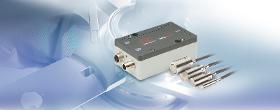- europages
- >
- COMPANIES - SUPPLIERS - SERVICE PROVIDERS
- >
- laser profile sensors
Results for
Laser profile sensors - Import export

MICRO-EPSILON
Germany
scanCONTROL 30x2 laser scanners are powerful profile sensors in terms of size, accuracy and measuring rate. These laser scanners provide calibrated 2D profile data with up to approx. 8 million points per second. With a maximum profile frequency of 10 kHz, the scanners are designed for precise profile measurements in dynamic processes. The sensor matrix offers a resolution of 1,024 points with a point distance from 24 µm. This means that even small details can be detected reliably.
Request for a quote
DIGITAL SURF
France
Dedicated imaging, analysis and metrology software for scanning 3D surface profilometers using contact or non-contact techniques - including stylus profilers, laser triangulation profilers, confocal point sensor profilers, auto-focus profilers and white light interferometers Compatible with all scanning 3D surface profilometers used for surface analysis and metrology. Real time 3D imaging of surface topography - at any zoom level, angle and height amplification. Correct measurement artifacts - spikes, anomalous scan lines, missing data points, tip impact. Analyze surface geometry - distances, angles, areas, volumes, step heights, coplanarity. Apply advanced roughness/waviness filtering techniques - defined in ISO 16610. Analyze surface texture - in accordance with the latest ISO and national standards, including ISO 25178 and ISO 4287. Extract and analyze sub-surfaces - study them just like full measured surfaces. Increase profilometer vertical range virtually in software - combine measurements made at different heights. Easy integration into lab and production environments - export of all numerical results. Add optional modules for advanced surface texture and form analysis, contour analysis, grains and particles analysis, FFT-based analysis and more.
Request for a quote
QUELLTECH GMBH
Germany
Wear is a damage consisting in gradual removal or deformation of material on solid surfaces, caused by mechanical (e.g. erosion) or chemical (e.g. corrosion) influences. In machine elements, wear may give rise to material failure or loss of functionality. For the application in question, our client has to measure wear on the surface of rollers in cement mills. Up from a certain depth, reactions are required, generated by a warning system to be developed In this project, we used several robust QuellTech Q6 scanners to cover fully the roller width. Due to the high rotational speed of the rollers, we preferred our fastest scanners for this application. We furthermore developed a software solution and implemented a warning system, based on the critical depth of the wears on the surface. By means of this system, the customer can determine the correct time for exchange of the rollers.
Request for a quote
QUELLTECH GMBH
Germany
Q6-Lasor sensor – High Speed, High Resolution – Q6 Sets New Standards for 2D / 3D Measurement: Resolution of up to 0.6 µm Profile speed of up to 25.000 profiles/s Measuring ranges between 2 mm and up to 370 mm available Laser wave lengths starting from UV via blue, red and green through to IR The Q6 laser sensor series has already proven its ability in numerous industrial applications demanding a high degree of precision and process stability at increased travel speed. For common environments, connection is established via GIGE interface and GeniCam. Integration with linear axes and robots is possible by means of encoder inputs and trigger option.
Request for a quote
MICRO-EPSILON
Germany
Non-contact, inductive displacement sensors from Micro-Epsilon operate according to the eddy current measuring principle. Unlike conventional, inductive displacement sensors, they measure on ferromagnetic and non-ferromagnetic materials providing high accuracy, frequency response and temperature stability. Due to their immunity to oil, dirt, pressure and temperature, these inductive eddy current sensors are primarily used for integration in machines and facilities.
Request for a quoteDo you sell or make similar products?
Sign up to europages and have your products listed

IPF ELECTRONIC GMBH
Germany
Optical sensors function contactlessly. They detect objects independent of their characteristics (e.g., shape, color, surface structure, material). The basic operating principle is based on the transmission and reception of light. There are three different versions: 1. The through-beam sensor consists of two separate devices, a transmitter and a receiver that are aligned with one another. If the light beam between the two devices is interrupted, the switching output integrated in the receiver changes its status. 2. With the retro-reflective sensor, the transmitter and receiver are located in one device. The emitted light beam is reflected back to the receiver by a reflector that is to be mounted opposite the device. As soon as the light beam is interrupted, the switching output integrated in the device changes its status. 3. With the diffuse reflection sensor, the transmitter and receiver are in one device. The emitted light beam is reflected by the object that is to be detected.
Request for a quoteResults for
Laser profile sensors - Import exportNumber of results
7 ProductsCountries
Company type
Category